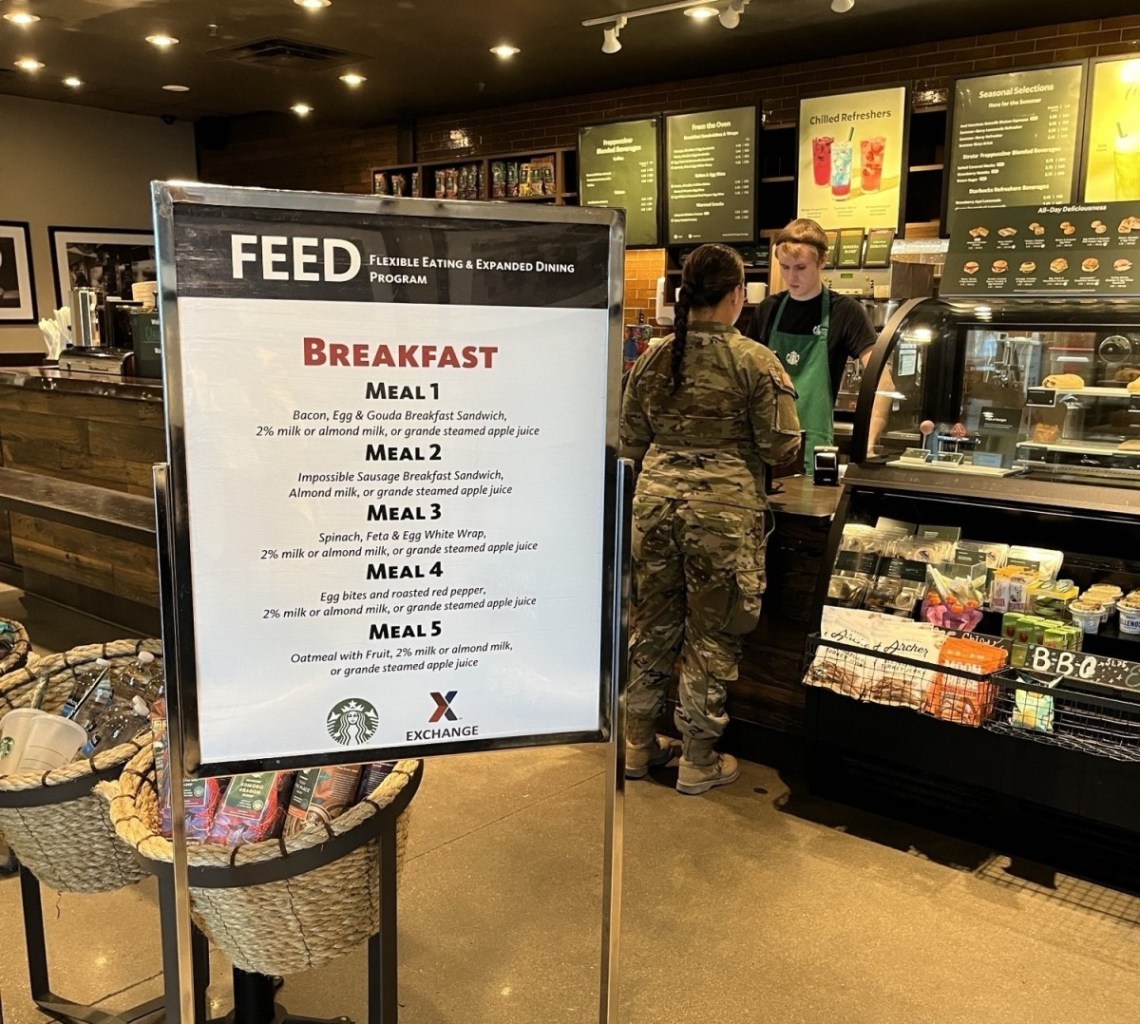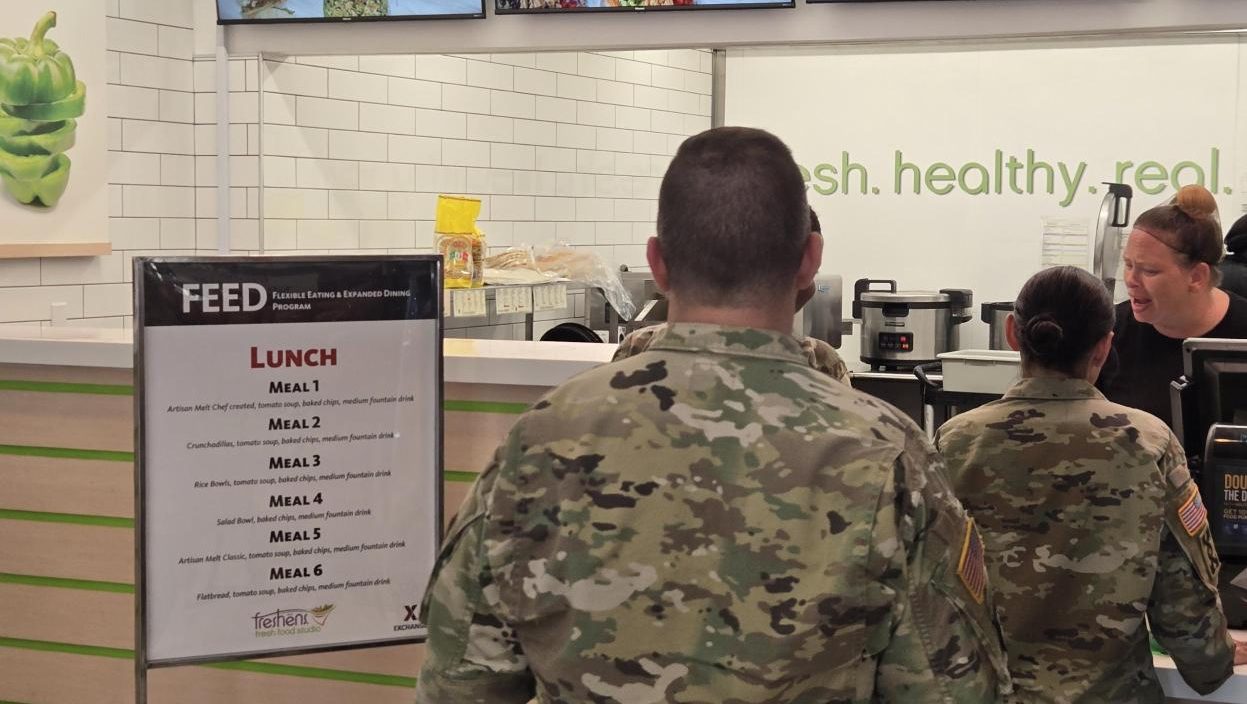On Aug. 11, five Exchange name-brand restaurants at Fort Hood began offering breakfast, lunch and dinner to 200 selected service members as part of their meal entitlement during a two-week test of a groundbreaking Army feeding initiative.
The Limited User Assessment Test (LUAT) for the Army’s Flexible Eating & Expanded Dining (FEED) program is the next step in strengthening nutritional readiness with a focus on convenience and accessibility.
The test—in which service members use their CAC cards for select breakfast, lunch and dinner meals at Burger King, Freshens and Qdoba at Fort Hood’s T.J. Mills Food Court; Subway in the Clear Creek Food Court; and Starbucks in both locations—is designed to confirm Army entitlement and Exchange POS platforms communicate effectively, in real time.
Once the LUAT is completed at Fort Hood and the results and feedback have been reviewed, the Army will initiate discussions on the next phase of the pilot, potentially expanding to Forts Bragg, Carson, Drum and Stewart. In the future, FEED programs could be implemented at more than 300 Exchange facilities on Army installations around the world.
“This is a significant opportunity to further enhance our Warfighters’ readiness, resilience, retention and lethality,” Director/CEO Tom Shull said at Fort Hood. “After nearly a decade of planning and collaboration, the Exchange’s IT, accounting, policy and food service teams are fully nested with Army leadership’s and leaning forward as a partner in this critical effort to deliver a true campus-style dining experience to the communities the Exchange is honored to serve.”

Increasing dining flexibility and convenience
At Fort Hood, Shull met and discussed the FEED program with Army Materiel Command Acting Commander Lt. Gen. Chris Mohan and Lt. Gen. Kevin Admiral, commanding general, III Corps & Fort Hood.
Mohan said in an Army.mil article that FEED is intended to meet the needs of modern Soldiers, who want more flexibility in dining options and times.
“We’ve expected Soldiers in barracks to follow the same eating patterns that we have maintained for decades,” Mohan said. “We were swinging behind the pitch and failing them. We are on the cusp of totally changing that.”
Exchange restaurants have longer hours than installation dining facilities, increasing convenience for Soldiers using their entitlements. Pfc. Renee Myatt, a driver who is also in school, told Stars & Stripes that she appreciates the increased flexibility.
“Once I’m done with work, I need a quick and easy meal to go,” she told Stars & Stripes. “I don’t want to be waiting in a [dining facility] line. It’s quick, simple and easy for me.”

Keeping nutrition in mind
Shull honored several Fort Hood associates who were involved with the test, presenting them and Mid-Central Region Vice President Scott Bonner with his challenge coin. The next day at headquarters, he presented coins to Vice President of Food Danita Jones and more than a dozen Services and Food, IT, Procurement, Policy and General Counsel associates.
Jones said the program was the result of a collaborative effort among several headquarters directorates, stemming from discussions that began nearly a decade ago. The Exchange had been working with AMC to launch FEED under previous leadership before she assumed responsibility for the program in August 2023.
“The program ensures nutrition for Soldiers is the priority,” Jones said. “Military dietitians reviewed our menus and made selections, determining which items met nutritional qualifications and could be options for Soldiers. They were responsible for selecting the brands that would participate in the LUAT as well as approving menu options.”
Early AMC discussions identified Fort Hood as their number one installation to launch the FEED test.
Two Fort Hood units, the 61st Quartermaster Battalion and the 49th Transportation Battalion, are participating in the test. The 200 Soldiers, who all live in barracks, were asked to dine at as many of the Exchange restaurants as possible during the test. Their meal entitlement allowed them to eat select breakfast, lunch and dinner items. The service members were issued a “smart book” that described the program and the meals, which are prominently displayed on signs at in the food courts.
Troops were asked for feedback before, during and after the LUAT—to evaluate the process and the systems involved, and to report any problems with CAC card-swipes or other issues.
Chief Master Sgt. Rich Martinez, the Exchange’s senior enlisted advisor, underscored the importance of the pilot program.
“The food that we provide Warfighters is the catalyst for human performance, enabling them to do their jobs effectively,” he said. “The Exchange’s participation allows the services to leave that focus to us and move it to a higher level. When people talk about the relevancy of the Exchange, this is just another facet of that.”



Leave a Reply to Teri Wright Cancel reply